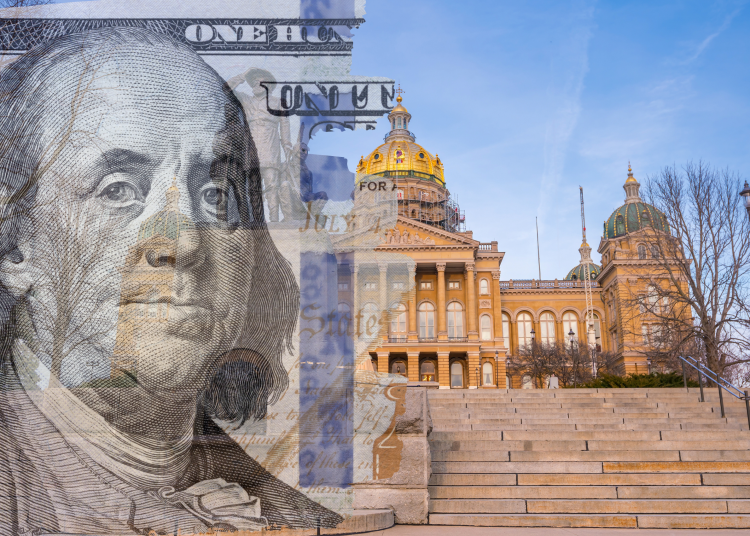Sound tax policy begins with conservative budgeting. Last week both the Iowa House and Senate announced their budget targets for the Fiscal Year 2025 budget. Budget targets are used as benchmarks to determine how the various departments and programs within the General Fund will be funded. Last year, the legislature passed an $8.5 billion Fiscal Year 2024 budget. During the Condition of the State Address, Governor Kim Reynolds proposed an $8.91 billion FY 2025 budget. Iowa House Republicans have now proposed a FY 25 budget of $8.95 billion, while the Senate is proposing an $8.87 billion budget. The Senate’s budget target is the best approach because it keeps spending within the limit of population growth and inflation.
Although all three budget targets are similar, it is important to continue to control the growth of spending. For the past several years this has been a priority for both Governor Reynolds and the Republican-led legislature. The FY25 budget will also have major implications for any future income tax relief. Senator Jason Schultz correctly warned during a recent subcommittee meeting that “both Republicans and Democrats need to realize that tax policy is affected by spending. And when you start seeing spending creeping up for annual, year after year, new good ideas, you can’t have good tax policy.”
It is the direct result of conservative budgeting that Iowa’s fiscal house is on a solid foundation. Both Moody’s and Fitch recently reaffirmed Iowa’s AAA bond rating. For the past several years Iowa’s budget has been in surplus, which has swelled the Taxpayer Relief Fund to have a balance of $3.7 billion. Budget surpluses continue to be expected for both FY 2024 ($1.9 billion) and FY 2025 ($2.9 billion). This includes Iowa’s reserve accounts (Cash Reserve Fund and Economic Emergency Fund) projecting to be full in FY 2024 ($961 billion) and FY 2025 ($963 billion).
“The outlook of the state is stable, reflecting an economy that continues to diversify, strong governance practices that result in closely managed finances with healthy reserves and a relatively low debt and pension burden,” reflected Moody’s in describing the economic and fiscal outlook of Iowa.
Iowa Senate Majority Leader Jack Whitver correctly notes that Iowa’s economy is strong as a result of fiscal conservatism, even with all of the national economic uncertainty. “Iowa is in great fiscal shape and the economy is strong despite the headwinds of the Biden economy,” stated Leader Whitver. Further, Leader Whitver is confident that the legislature will act on additional income tax relief for taxpayers. “I am optimistic we can do more for the taxpayer before this legislature adjourns,” noted Leader Whitver. Governor Reynolds has also stated the need for further income tax relief.
“Our conservative budgeting practices should continue to allow us to return tax dollars to the hard-working men and women of Iowa – where they belong,” she said.
Doing more for the taxpayer should be done soon. With close to $4 billion in the Taxpayer Relief Fund, continual budget surpluses, and full reserve accounts, it is clear that Iowa continues to collect too much from taxpayers. Additionally, the longer the legislature waits to use the Taxpayer Relief Fund for its intended purpose of income tax relief, there is a growing temptation to start spending those dollars on further government spending or even temporarily “buying” down property taxes. If the Taxpayer Relief Fund can’t be used for tax cuts right away, policymakers would be wise to ensure that it is only used for income tax relief.
At the moment, the legislature is considering two tax reform plans. Governor Reynolds has introduced a tax reform plan that would accelerate existing income tax rate cuts and further lower the flat tax. The governor’s plan would fully implement a 3.65 percent flat tax this year, and the rate would further be lowered to a flat 3.5 percent in 2025.
The other plan being deliberated was released by the House and Senate in a joint reform proposal. Under the House-Senate plan, income tax rates would be gradually reduced until a 3.65 percent flat rate is reached in 2027. Further, the Taxpayer Relief Fund would be used to create a new trust fund specifically devoted to gradually eliminating the income tax using budget surpluses.
In recent years, Iowa has made substantial progress on reducing income tax rates. Iowa is scheduled to move to a flat 3.9 percent income tax in 2026, but accelerating rate cuts and achieving an even lower flat tax rate is in the best interest for the taxpayer and the economy. Iowa is also in direct competition with other states for both jobs and people. As states, including some of Iowa’s neighbors, continue to lower rates it only makes that competition more fierce.
Sound tax policy begins with conservative budgeting. Governor Reynolds and the legislature have made Iowa a national leader in conservative budgeting and pro-growth tax reforms. The goal of the FY25 budget should be to reflect the average taxpayer’s ability to pay for the budget. In the coming weeks it will be essential to stick to that goal.
















